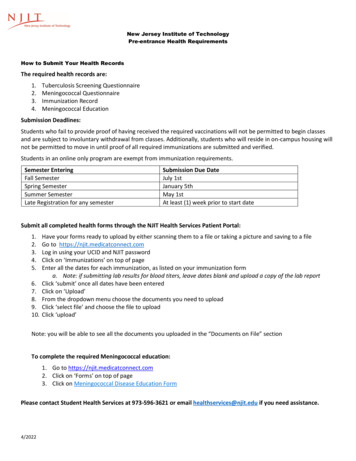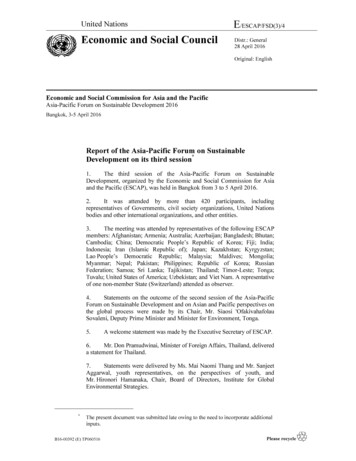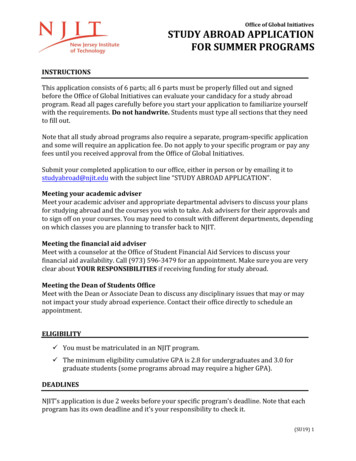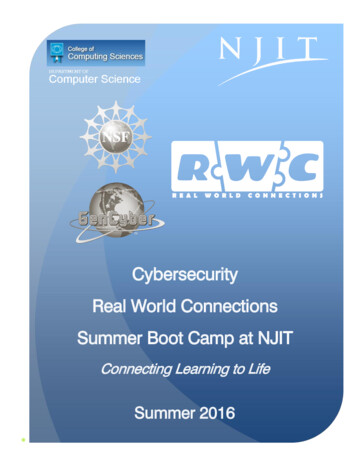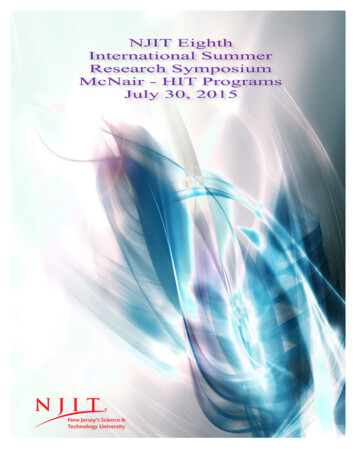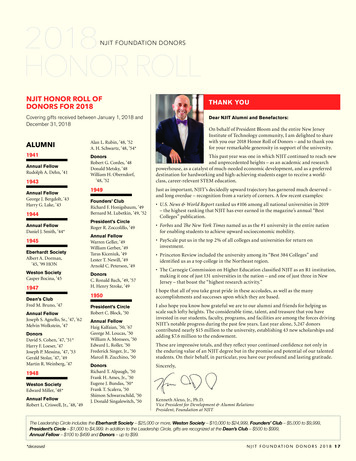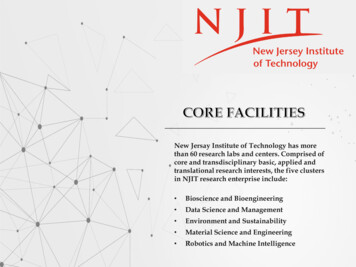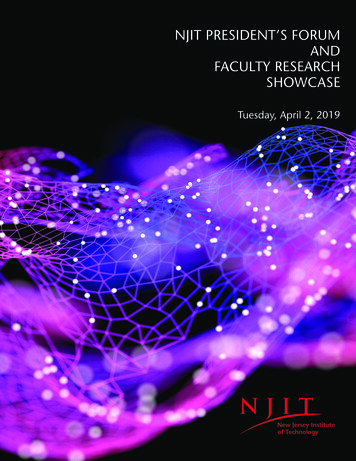
Transcription
NJIT PRESIDENT’S FORUMANDFACULTY RESEARCHSHOWCASETuesday, April 2, 2019
NJIT PRESIDEN T’ S FO RUM A N D FA CULTY RESE A R C H SH O W C A SE 2 0 1 9The President’s ForumAs one of only 32 polytechnic universities in the United States, New JerseyInstitute of Technology (NJIT) fills a critical role in a world that is being driven bytechnological innovation. All the major industries that drive our global economy aretechnology enterprises at their core, and they rely upon scientific and technologicalinnovations to enhance efficiency and yield new and/or improve products. Inaddition to educating a highly diverse and exceptionally accomplished studentbody and preparing them to become the science, technology, engineering and math(STEM) workforce sought after by all industries, NJIT is an elite research university.We now conduct more than 162 million in applied research annually, solving realworld problems in areas that include civil infrastructure, advanced manufacturing,cybersecurity, transportation, medical devices, clean energy, national defense,health care and many others. The growth of our research portfolio has earned us therecently announced distinction of being designated an “R1” research university by the Carnegie Classification , whichindicates the highest level of research activity. NJIT is one of only 131 universities nationally and just three in NewJersey—Princeton and Rutgers are the others—to achieve this recognition.NJIT hosts the President’s Forum and Faculty Research Showcase each year to highlight a range of research initiativesand stimulate collaboration around significant opportunities for future exploration. As part of the Albert DormanHonors College Colloquium Series and through the generous support of the DeCaprio family, the President’s Forumprovides for the NJIT community a unique opportunity for learning and discussion. The Faculty Research Showcaseoffers an overview of the future of research at NJIT, with presentations that introduce our newest faculty and theirimpressive work to NJIT’s research community, in addition to seed grant posters that illustrate the ideas and innovationsbeing produced by long-standing members of the NJIT community. Faculty seed grants represent NJIT’s commitmentto supporting promising research with funding that enables development of a concept into a proposal that can attractsignificant external resources from the National Science Foundation and the National Institutes of Health, as well asother agencies and foundations.This day allows us to celebrate the exceptional research and innovation occurring at NJIT while demonstrating theextraordinary ability of our faculty and the importance of their work in improving our world and our lives.Joel S. BloomPresident of NJIT2
NJIT PRESIDEN T’ S FO RUM A N D FA CULTY RESE A R C H SH O W C A SE 2 0 1 9Transforming the Research Enterprise at NJITOver the past four decades, NJIT has evolved from a commuter school teachingapplied engineering skills into a nationally ranked public research university. In1979, our research expenditures totaled 375,000; today they surpass 160 million.As our research profile grew, so did our capacity as an educational institution.NJIT has been awarding doctoral degrees for more than 50 years; since 2014, thePh.D. student population has increased by 30 percent, while the number of degreesawarded last year was 73, the highest ever.As evidence of our remarkable transformation, NJIT recently joined the top tier ofresearch universities with a designation of R1 by the Carnegie Classification . Weare one of just three universities in New Jersey to occupy the category indicating“very high research activity.”Developing knowledge and applying it to the benefit of society requires talent, substance and resources. We are activelyrecruiting, developing, supporting and retaining an exceptional faculty, and are continually striving to provide theenvironment necessary for success from the moment of their appointment to the peak of our scholars’ academic careers.We also aim to break down barriers to multidisciplinary collaborations as contemporary research demands it. We valueentrepreneurial research, promote our inventions and facilitate technology transfer.As we embark on our new strategic plan, NJIT 2025, research remains one of our five core priorities. We will continueto encourage and promote groundbreaking research in many fields as we aim for prominence. Our ambition is nowheremore apparent than in our people. Over the past six years, NJIT has hired nearly 130 new faculty members as wedeepen our capabilities across STEM and other disciplines, increasing its faculty from 268 in 2014 to a projected 345 by2020. They include experts on topics such as machine learning, data analytics, biomaterials and biomechanics. Theseenterprising scholars bring us not only original research and cutting-edge investigative methods from the country’stop academic institutions, but an energizing diversity that renews our traditional disciplines and broadens our researchscope. Over the past four years, 12 young researchers have won CAREER awards from the National Science Foundation.So it is with enormous pride that NJIT showcases its growing research talent in the Sixth Faculty Research Showcase.Some of the presentations you will hear today represent interdisciplinary collaborations brought to life on campus withseed funding from an NJIT research program designed to tackle problems that represent the university’s core strengthsin fields such as the life sciences and health care, sustainable systems and data science. They bridge disciplines asdistinct as physics and design. As we create new academic hubs on campus, we hope to inspire many more productivepartnerships. We have more than doubled research funding from external sources since the 2014 baseline of our currentstrategic plan, 2020 Vision.We will also measure the impact of our ambitious transformation from multiple perspectives. Critically, we will assessour success in materially improving lives both in our immediate region and in communities across the globe thatbenefit from the technology we develop and effectively deploy. Just as importantly, we will judge our achievement by thenumber of technology innovators we nurture in our undergraduate and graduate programs, exposing them to high-levelresearch and real-world applications, so they are empowered to confidently take on the problems of tomorrow.Fadi P. DeekProvost and Senior Executive Vice President3
NJIT PRESIDEN T’ S FO RUM A N D FA CULTY RESE A R C H SH O W C A SE 2 0 1 9ProgramCampus Center, Ballrooms A and B10 a.m. – 10:15 a.m.Welcome RemarksJoel BloomPresident of NJITVince DeCaprioVice Chair, NJIT Board of TrusteesFadi DeekProvost and Senior Executive Vice President10:15 a.m. – 10:20 a.m.Speaker IntroductionAtam DhawanSenior Vice Provost for Research10:20 a.m. – 11:30 a.m.President’s Forum: Keynote LectureDr. Chenzhong LiProgram Director, Biosensing Program, CBET, NSF11:30 a.m. – 12:15 p.m.12:15 p.m. – 2 p.m.Lunch and NetworkingNew Faculty Presentations2 p.m. – 3 p.m.Poster Presentations and Networking Session:New Faculty and Faculty Seed Grant RecipientsThis forum is a featured event in theAlbert Dorman Honors College Colloquium Seriesand is made possible in part by thegenerous support of the DeCaprio Family.4
NJIT PRESIDEN T’ S FO RUM A N D FA CULTY RESE A R C H SH O W C A SE 2 0 1 9Keynote SpeakerChenzhong LiWorlds Ahead Professor of Biomedical Engineering, Chemistry and Immunology and Director of theNanobioengineering/Bioelectronics Lab at Florida International UniversityProgram Director of the Biosensing program in the Division of Chemical, Bioengineering, Environmental andTransport Systems of the National Science FoundationChenzhong Li is an expert in bioinstrumentation and bioelectronics, focusing on thedevelopment of biomedical devices for both diagnostic and therapeutic applicationsand with further potential in areas ranging from the environment, to food safetymonitoring, to agriculture, to homeland security. He is the co-principal investigatorof two newly funded National Science Foundation (NSF) Engineering ResearchCenters, which focus on developing technologies for smart health diagnosis systemsand artificial heart tissues, respectively.Dr. Li’s research has been documented in 10 granted patents, about 140 peerreviewed journal papers and 10 books and book chapters. His numerous awardsinclude the Kauffman Entrepreneurship Professor Award in 2009 and 2011; the2014 JSPS (Japan) Professor Fellowship Award; the 2014 Florida International University Excellent Faculty Award inResearch; the 2016 Pioneer in Technology Development Award by the Society for Brain Mapping & Therapeutics; andthe 2016 Minority-Serving Institution Faculty Award in Cancer Research from the American Association for CancerResearch. He is a fellow of the American Institute for Medical and Biological Engineering; Associate Editor of Biosensorsand Bioelectronics; and Editor-in-Chief of the Journal of Critical Review of Biomedical Engineering.Keynote Lecture: NSF Perspectives: Challenge and Opportunity inBioinstrumentation ResearchResearch funding, as is true of many opportunities, undergoes shifts. As funding levels change, priorities are altered,and application numbers vary, applicants should employ savvy strategies when seeking support. In this presentation, Iwill present my perspective on developing and sustaining collaborative research projects with particular emphasis onresearch in the field of Biomedical Engineering and Bioinstrumentation, such as biosensors. The presentation is basedon my 25 years of experience gained during my own research, my service as a program director to the NSF Biosensingprogram and as an editor and reviewer of several flagship journals in the field of bioinstrumentation.The emphasis is on the funding opportunity of the NSF Biosensing program, which supports fundamental engineeringresearch on devices and methods for the measurement and quantification of biological analytes. However, inkeeping with the main aim of this talk of providing a perspective on sustainable project development, other researchopportunities within the Chemical, Bioengineering, Environmental and Transport Systems (CBET) Division’s“Bio clusters” within the Engineering Directorate of the NSF will be provided. In addition, information about NSFcrosscutting initiatives and training grants such as NSF Career Awards, NSF Engineering Research Center and NSFResearch Traineeship will also be discussed.5
NJIT PRESIDEN T’ S FO RUM A N D FA CULTY RESE A R C H SH O W C A SE 2 0 1 9New Faculty Research PresentationsCollege of Science and Liberal ArtsTravis AskhamAssistant Professor of Mathematical SciencesTravis Askham comes to NJIT from the University of Washington where he was a research associate of appliedmathematics. He engages in research in scientific computing, broadly defined. Recent projects include thedevelopment of robust algorithms for data-driven model discovery in dynamical systems; the application ofasymptotic analysis to a model of the “frequency combs” of high-throughput optics; and work on the foundations offast algorithms for solving the classical partial differential equations governing electromagnetism, fluid dynamics andelasticity. These classical and modern models apply to a wide range of topics in science and engineering. They are keycomponents of the analysis of optical communication systems, the machine learning approach to optimal controlsystems, and the computer-aided design of medical, scientific and military devices for which fluid or electromagneticfields affect performance. While a Ph.D. student at the Courant Institute of Mathematical Sciences at New YorkUniversity, Askham was awarded a Dean’s Dissertation Fellowship and received a department prize for contributionsto mathematics. His research has appeared in top journals, including the Journal of Computational Physics andSIAM Review.Title: Modern Methods in Scientific ComputingMy work focuses on modern methods for scientific computing. In particular, I am interested in high order methodsfor simulating the partial differential equations which govern many physical phenomena, including fluid dynamics,electromagnetism and solid mechanics. These methods are based on novel integral equation formulations of thegoverning equations, so the work entails both a theoretical and algorithmic component. I have also developedmethods for efficiently solving the data-fitting and model-discovery problems of machine learning, which allow fordomain-specific knowledge to be incorporated into the problem formulation.Pier Alexandre ChampagneAssistant Professor of ChemistryPier Alexandre Champagne joined NJIT from the University of Ottawa, where he was a postdoctoral researcher inthe Department of Chemistry and Biomolecular Sciences. His research interests are centered on organic chemistry,with an emphasis on the development of new synthetic methods based on reactive intermediates – transient chemicalspecies that decompose readily. These compounds are then harnessed for use in new processes for synthesizingcomplex molecules, such as anti-cancer agents, in an efficient, modular fashion that also reduces waste. Champagnealso uses computational methods to understand reactivity in the fields of organic chemistry, catalysis and reactiveintermediates, then make predictions about ways to improve inefficient or unselective reactions. After obtaining hisPh.D. in organic chemistry from Université Laval in Quebec City, he went on a postdoctoral stint at UCLA to learnapplied computational methods for organic chemistry. Overall, Champagne’s research has been published in leadingjournals such as the Journal of the American Chemical Society and Wiley’s Angewandte Chemie.Title: Developing New Synthetic Tools through Experiments and ComputationsThe development of new tools aimed at the synthesis of previously unattainable molecules often brings a lot ofproblems and questions. As such, using computational methods to study reaction mechanisms in parallel withexperiments is now a very powerful tool to identify the source of the problems and predict ways to solve the issues.Our research has always been focused on organic chemistry, and we have demonstrated over the years how thecombination of experimental and computational methods proved instrumental to uncover the full picture in avariety of organic chemistry projects. Our current research endeavors are approached using the same mindset, thatunderstanding the chemistry can bring better tools to fruition.6
NJIT PRESIDEN T’ S FO RUM A N D FA CULTY RESE A R C H SH O W C A SE 2 0 1 9Hao ChenProfessor of ChemistryHao Chen focuses on the development of modern organic and biological mass spectrometry, a technique whichcan weigh molecules accurately. Mass spectrometry is a fascinating technology which plays an increasing impact inchemical measurement and imaging for a variety of areas such as analytical chemistry, environmental chemistry,forensic chemistry and life science research nowadays. So far, he has published over 100 papers in peer-reviewedjournals such as the Journal of American Chemical Society and Analytical Chemistry. He has also obtained 10 patentsfor novel instrument development. His research awards include the NSF CAREER Award, the American Societyfor Mass Spectrometry Research Award, the Merck Technology Collaboration Award, the Ron Hites OutstandingPublication Award and the Presidential Research Scholar Award from Ohio University.Title: Mass Spectrometric Study of ElectrochemistryElectrochemistry coupled with mass spectrometry (EC/MS) is a powerful means for identifying the products orintermediates of electrochemical reactions, which is not only useful for redox reaction mechanism elucidation butalso leads to valuable applications in proteomics. The versatility of EC/MS stems from two facts. First, MS can serveas a sensitive and general detector for investigating electrolytic products of proteins. In addition, tandem MS analysiscan be used for structural determination based on ion dissociation. Second, electrochemical conversion can improveanalyte ionization efficiency, provide desired modification to the analyte prior to MS analysis or even facilitate MSquantitation of chemicals. Attracted by the complementary nature of these two techniques, the marriage of EC andMS appears quite attractive. In this talk, I will focus on the development of electrochemical mass spectrometry and itsapplications for proteomics study.Rosanna DentAssistant Professor of HistoryRosanna Dent received her Ph.D. in History and Sociology of Science from the University of Pennsylvania in 2017 andjoins NJIT from a Mellon Postdoctoral Fellowship at McGill University. She teaches and writes about the social andpolitical history of science, medicine and technology in the Global South, particularly Latin America. She is interestedin the ethical and affective dynamics of human subjects research, and how knowledge-making shapes those whoparticipate. In her research, Dent combines oral history, ethnography and archival work to illuminate often-overlookedhistories of science, focusing on the role of Indigenous people in teaching and training those who come to study them.She co-coordinates a digital archive project to return scientific publications and historical materials to highly studiedXavante communities in Central Brazil. Her work has been supported by Fulbright IIE, the Social Science ResearchCouncil, the American Council of Learned Societies and the Andrew W. Mellon Foundation.Title: Indigenous Histories of ScienceWhat is it like to be studied again and again? How often would you consent to be questioned, measured and sampled?Some Xavante Elders in Central Brazil have hosted so many researchers they no longer remember all the names andproject proposals that have come their way since 1958. They know they have been featured in genetics papers, publichealth journals, anthropology textbooks, and linguistics manuals. They know I am writing a book about their long andsometimes fraught engagement with scientists. Understanding their reasons for participating illuminates the politicalsalience of knowledge production under colonial regimes. It highlights broader implications of scholarship in researchsaturated settings where subjects become experts and knowledge and power are inextricably linked.7
NJIT PRESIDEN T’ S FO RUM A N D FA CULTY RESE A R C H SH O W C A SE 2 0 1 9Hyomin KimAssistant Professor of PhysicsHyomin Kim comes to NJIT from Virginia Tech, where he was a postdoctoral research fellow and research assistantprofessor in the Department of Electrical and Computer Engineering. He researches the impact of solar emissionssuch as radiation and charged particles on Earth’s geomagnetic environment and human technologies. His analysis ofmagnetic field waves, caused by the interaction of solar wind with space plasma particles, shows how solar energy istransferred to Earth’s upper atmosphere. To that end, he serves as Deputy Director of the Center for Solar-TerrestrialResearch Polar Engineering Development Center for operation and on-site service of NJIT’s Antarctic stationsfor space research. He is also a science team member of the NASA Radiation Belt Storm Probe Ion CompositionExperiment mission to study the Earth’s radiation belts. He has visited various Arctic and Antarctic regions foroperations of science instruments. He is also interested in collaborations between the arts and sciences to encouragethe broader community to engage in science activities.Title: Large-Scale Multi-Point Observations for Solar-Terrestrial ResearchA flow of charged particles released from the upper atmosphere of the Sun, called the solar wind, is connected to theEarth’s magnetic environment, forming unique structures called the magnetosphere and ionosphere, and impactinghuman technologies adversely with what is known as space weather. This talk reports developments in and theoperation of ground-based instrument arrays in various Polar Regions in both hemispheres, critical infrastructure forthe study of the solar-terrestrial environment and for prediction of space weather. Through collaborations with U.Sand international institutes, a large-scale, high-latitude instrument network is now being established and expandedunder the leadership of NJIT’s Center for Solar-Terrestrial Research. In this talk, examples of large-scale multi-pointobservations of waves and particles in space plasmas are also presented using data from various spacecraft and highlatitude ground-based instruments. Waves and particles in space provide crucial information to study how energyfrom the Sun is connected to the Earth’s environment.Enkeleida LushiAssistant Professor of Mathematical SciencesEnkeleida Lushi joins NJIT from the Flatiron Institute where she specialized in soft matter and biological physics.Working at the intersection of biology, physics and fluid mechanics, she specializes in building high-fidelitymathematical models and fast computer simulations to elucidate phenomena such as the self-assembly and guidedtransport of micro-scale particles and the collective motion of microbes. Her focus so far has been on micro-swimmerssuch as bacteria and algae, as well as other types of “active” particles, such as electromagnetically-driven colloids.The models describe particle dynamics at the individual and suspension level, but include particle interactions andindividual traits which play non-trivial roles in the emerging macroscopic properties of the collective. Her aim is todetermine what drives the complex dynamics, and then use this knowledge to predict, for example, what types ofconfinements can enhance or hinder collective particle motion, or how to build materials with tunable properties.Lushi collaborates with experimentalists and engineers from all over the world and is well known for her work on thearea of active matter.Title: Confined dynamics of micro-swimmersInteractions between motile microorganisms and solid boundaries play an important role in many biologicaland technological processes. I will discuss recent advances in modeling, simulations and experiments that aim tounderstand the motion of micro-swimmers such as bacteria, micro-algae or spermatozoa in confined geometries orstructured environments. The results highlight the complex interplay of the fluidic and contact interactions of theindividuals with each other and the boundaries that give rise to complex behavior.8
NJIT PRESIDEN T’ S FO RUM A N D FA CULTY RESE A R C H SH O W C A SE 2 0 1 9James MacLaurinAssistant Professor of Mathematical BiologyJames MacLaurin studies how biological order, synchrony and patterns can arise out of disorder and stochasticityat the microscopic level. One of his major interests is understanding how ensembles of neurons in the brain candisplay coherent emergent behavior, despite the fact that there can be considerable variability at the level of signaltransmission between neurons. Such coherent emergent patterns include traveling waves, spiral waves, and slowrhythmic alternations between activity and quiescence. He is also interested in studying oscillations, coherent behaviorand synchronization in the activity of large ensembles of cells – the synchronization can result from correlations incommon inputs received by all of the cells. He also has pursued research in the biomechanical modeling of growingcancer tumors in the body. His work determines conditions under which the stress resulting from rapid proliferationof the cancer cells leads to mechanical buckling of the capillaries.Title: Biological Order and Synchrony Arising out of Microscopic RandomnessEmergent phenomena such as waves and oscillations are integral to normal brain function. They persist in spite ofmuch disorder and seeming randomness at the microscopic level. I outline a method for identifying how microscopicdisorder and randomness perturbs the phase of brain-waves. Using this, I can then demonstrate that the orthogonal‘error’ stays small for very long periods of time. I also look at the emergence of synchronization in biological oscillatorswith some coherence in their common input.Gareth PerryAssistant Professor of PhysicsGareth Perry joins NJIT’s Center for Solar-Terrestrial Research from the University of Calgary, where he was apostdoctoral research associate in the Department of Physics and Astronomy. Perry is an experimental space physicistwho studies the interconnections between the Earth’s upper atmosphere and plasma environment, and the Sun.His primary focus is on disturbances in these systems and how they can have severe repercussions on a variety ofimportant systems such as the Global Navigation Satellite System, and over-the-horizon communications and radarsystems. Perry has extensive experience with ground-based and satellite-based solar-terrestrial science experiments,and served as Scientist in Charge of the Canadian CASSIOPE satellite on several occasions. His work has beenpublished in a number of preeminent solar-terrestrial physics journals, including the Geophysical Research Letters, theJournal of Geophysical Research and Radio Science. One of his most recent publications in Radio Science was recognizedas a journal highlight.Title: Space Weather Impacts on Global Communications InfrastructureLong-range, over-the-horizon radio communication systems rely on a wireless link established via the ionosphere,a region of plasma in the Earth’s upper atmosphere which acts as a reflecting medium for radio waves at particularfrequencies. Marconi first demonstrated this link with his famous 1901 transatlantic wireless experiment.Perturbations in the ionosphere’s plasma density, called ionospheric irregularities, are generated by energetic processesdriven by interactions between the plasma environments of the Sun and the Earth: space weather. The irregularitiescan scatter radio transmissions and disrupt long-range radio communications and monitoring (radar) altogether. Thegoal of this research is to provide new and compelling insight into the fundamental plasma physics responsible forradio wave scattering in the Earth’s ionosphere, particularly for radio links between the continental United States andthe northern polar regions of the Earth.9
NJIT PRESIDEN T’ S FO RUM A N D FA CULTY RESE A R C H SH O W C A SE 2 0 1 9Newark College of EngineeringMohsen AziziAssistant Professor of Electrical and Computer EngineeringMohsen Azizi comes to NJIT from Michigan Technological University (MTU), where he was an assistant professorof Electrical Engineering Technology. Prior to that, he was an R&D engineer at Pratt & Whitney Canada (PWC),Inc. His research has focused on the design and development of advanced distributed controllers and fault-diagnosismodules for large-scale systems such as microgrids, mechatronics and aerospace systems. At MTU, he designedoptimal and robust controllers and fault-diagnosis filters to maintain the resilient performance of microgrids in thepresence of environmental uncertainties, system faults and communication constraints. Also at MTU, he was involvedin an industry-sponsored project to establish the Industrial Control and Automation Laboratory and developed theassociated curriculum. At PWC, he designed advanced controllers and fault diagnosis modules for jet engines. Azizi isa senior member of IEEE, and has published 10 journal articles and 38 peer-reviewed conference papers.Title: Distributed Control and Fault Diagnosis in Large-Scale SystemsA “large-scale” system is defined as a system with multiple interconnected subsystems. The objective of this researchis to stabilize, regulate, and control the overall large-scale system by designing a local controller for each subsystem,and also to diagnose sensor/actuator faults and system failures by designing a local fault-diagnosis module foreach subsystem. The local controllers and fault-diagnosis modules are designed and implemented in a distributedframework, such that they mainly rely on their local information and minimum communications exist among them.This distributed control and fault-diagnosis approach is essential and applicable to a wide range of industrial systemsincluding microgrids, mechatronics and aerospace systems.Ashish BorgaonkarAssistant Professor of Engineering EducationAshish Borgaonkar joined the NJIT faculty this January after serving as Assistant Dean of Newark College ofEngineering beginning in 2013. He also obtained his Ph. D. in Environmental Engineering from NJIT. He is interestedin engineering education as a discipline, and in innovative teaching methods and pedagogies. These include hands-on,active-learning and peer instruction methods, as well as ways to help underprepared and still-deciding students. Hehas overseen the development, growth and implementation of several engineering education and academic supportprograms, including the NJIT mathematics summer boot camp, learning communities, practice placement exams, thefirst-year seminar, an application-based mathematics course for underprepared students and student design showcasesand competitions. He has also developed and co-teaches the Fundamentals of Engineering Design (FED101) coursefor General Engineering students. He has won several awards at NJIT, including the Excellence in Teaching Awards inthree different categories, and most recently, Outstanding Contribution to Teaching at NJIT.Title: Enhancing Engineering Education at NJIT by Utilizing the Makerspace and Active-Learning ActivitiesActive-learning methods in teaching have widely been reported to increase students’ enthusiasm and motivation topersist in their degree pursuit in STEM fields. They have shown to impact students’ retention and graduation rates.NJIT’s Makerspace has opened up several new opportunities to enhance engin
NJIT PRESIDENT'S FORUM AND FACULTY RESEARCH SHOWCASE 2019 6 New Faculty Research Presentations College of Science and Liberal Arts Travis Askham Assistant Professor of Mathematical Sciences Travis Askham comes to NJIT from the University of Washington where he was a research associate of applied mathematics.
